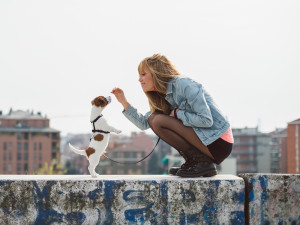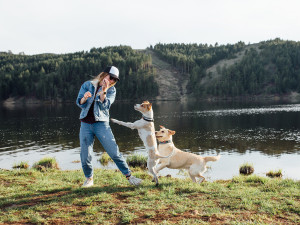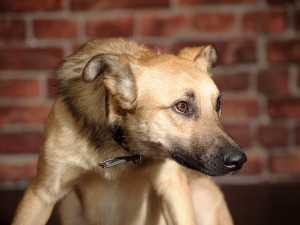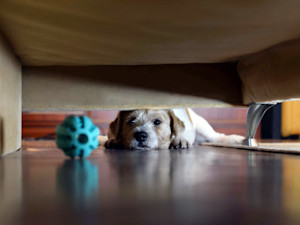How to Teach Your Dog to Take Treats Gently
And save your skin.
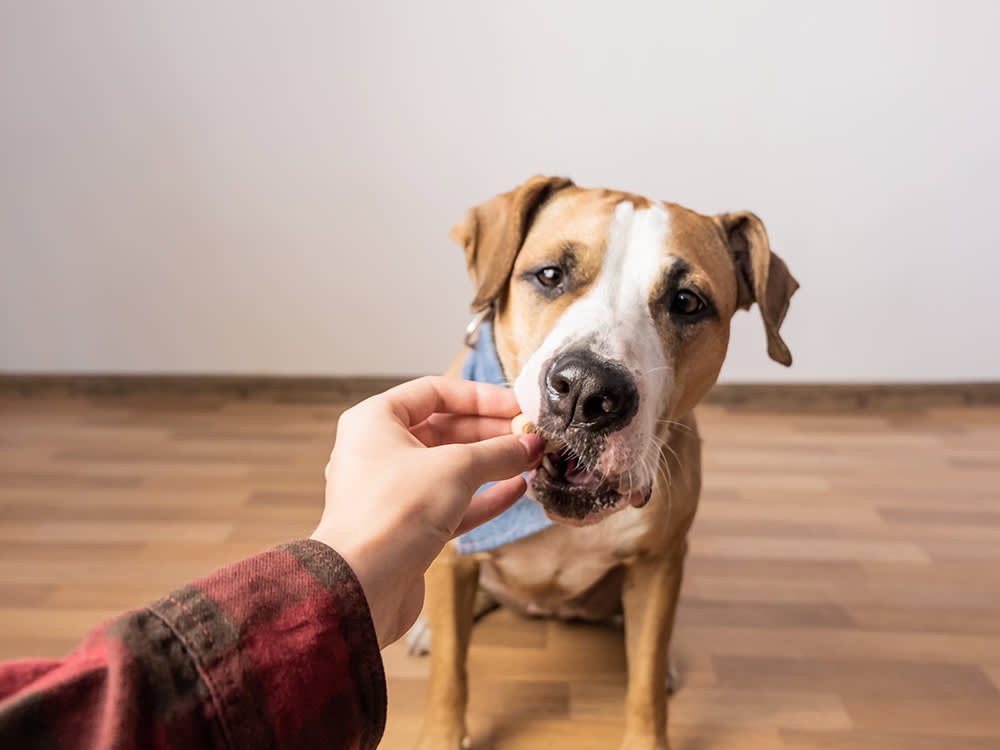
Share Article
Maybe it sounds familiar: One second your dog is showing off their perfect “sit,” and the next it seems like they’re going to swallow your whole hand along with the treat you promised them. You’re far from alone; enthusiastic treat takers are a dime a dozen.
Some dogs are only “chompy” when they’re revved up, so their eagerness can actually make a good assessment tool — in these cases, the intensity of the alligator-like behavior can indicate a dog’s arousal level. In any case, most dogs need lessons to achieve the chill treat-taking of a pet parent’s dreams, and this starts with teaching your dog the cue “gentle.” Training a dog who understands a “gentle” cue can relieve the frustration of wanting to reinforce your dog’s good behavior while also wanting your fingers to remain connected to your body.
Teach “gentle” to a dog.
You can avoid confusing your dog by teaching the cue “gentle” as its own behavior rather than during a training session for some other behavior. It’s important to not let snapping behavior be rewarded — that means you need to commit to the idea that your dog needs to take the treats gently or they don’t get a treat at all. We know it’s hard to resist those pleading eyes, but it’ll be for the best in the end.
To teach your dog what “gentle” means, hold a treat in your hand, close your fist around it, and offer your first to your dog. If your dog bites at your hand, keep it closed; this means either toughing it out or wearing gloves, depending on your dog’s behavior and your tolerance. When they stop biting and lick your hand (or even nibbles gently and painlessly), say “gentle” and open your hand completely to give them the treat.

Keep saying “gentle” each time you offer your pup a treat to help them associate the word with the behavior. If they return to their former alligator-like ways, pull your hand away and then offer the treat again, using the cue “gentle” to remind them of what you want. This will keep you from dropping the treat in response to the snapping.
Protect your fingers.
If you haven’t noticed, teaching this cue opens you up to having your hand attacked over and over and over. It’s all part of the process. As mentioned above, you might want to wear some tough gloves while teaching your dog to be gentle. But outside of training sessions or with other dogs, there some other ways to protect your hands.
At home, try putting cream cheese or peanut butter on a wooden spoon and offering your dog a chance to lick this food a few times. This is a simple way to reinforce your dog without putting your hands near their mouth.
In a dog park or class setting, you can offer a treat on your flat palm. Many dogs who will snap at treats held in the fingertips are able to take them properly when they are presented on an open hand. If that still doesn’t work, a final option is to drop the treats on the ground rather than giving them directly to your dog.
It takes a lot of repetition for most pups to learn to take treats gently, so have patience — and don’t bother trying to teach other dogs in rushed, infrequent sessions. The occasional effort to teach someone else’s dog by, for example, holding a treat in your closed hand is unlikely to be effective. Unless a pet parent is teaching this at home, save your fingers by either flat-palming the treats or tossing them on the ground. These techniques won’t teach your dog or their dog park friends to take the treats politely, but they do keep your fingers safe.

Karen B. London, PhD, CAAB, CPDT-KA
Karen B. London is a certified applied animal behaviorist (CAAB) and certified professional dog trainer (CPDT) who specializes in working with dogs with serious behavioral issues, including aggression. She has written for a variety of magazines including The Bark, Clean Run, and the APDT Chronicle of the Dog, and has published in scientific journals including Behavioral Ecology and Sociobiology, Ethology, Ecology, and Evolution, the Journal of Insect Behavior, and Insectes Sociaux. She is the author of seven books about dog training and canine behavior, including the forthcoming My Dog's Mystery Adventure: And Other Stories From a Canine Behaviorist and Dog Trainer.
Related articles
![woman gives small black dog treat for sitting]()
Your Dog Should Do This 30-Day Training Challenge
It’s like your 30-day yoga challenge — except with way more training treats.
![Young blonde woman with a Jack Russell puppy during spring in the city.]()
The Best Training Treats for Dogs in 2025
The most mouth-watering treats for training your pup.
How to Train a Dog Not to Jump
Kinship Collective dog trainer Robert Haussmann’s pro tips for getting a hyped-up dog to chill out.
![Scared tan dog against brick wall background]()
Does Your Dog’s Growl Mean Aggression?
Remember, dogs have more than one emotion.
![a small dog stares at a ball under the couch]()
Why Is My Dog Obsessed With Shoving Things Under the Couch?
Thankfully, I found an easy fix.
![Cute dog trying to get someone's attention.]()
9 Signs Your Dog Wants Your Attention Right Now
They need some cuddles, stat.


